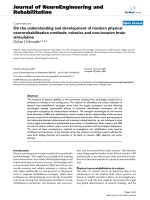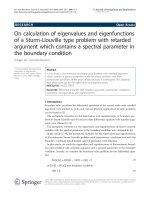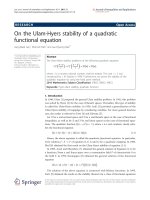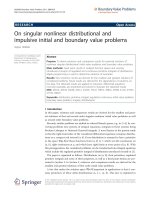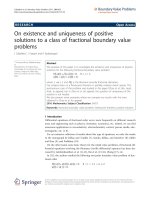Báo cáo hóa học: " On a boundary value problem of a class of generalized linear discrete-time systems" ppt
Bạn đang xem bản rút gọn của tài liệu. Xem và tải ngay bản đầy đủ của tài liệu tại đây (255.77 KB, 9 trang )
RESEARCH Open Access
On a boundary value problem of a class of
generalized linear discrete-time systems
Ioannis K Dassios
Correspondence:
gr
Department of Mathematics,
University of Athens,
Panepistimioupolis, Athens, Greece
Abstract
In this article, we study a boundary value problem of a class of generalized linear
discrete-time systems whose coefficients are square constant matrices. By using
matrix pencil theory, we obtain formulas for the solutions and we give necessary and
sufficient conditions for existence and uniqueness of solutions. Moreover, we provide
some numerical examples. These kinds of systems are inherent in many physical and
engineering phenomena.
Keywords: linear differe nce equations, boundary value problem, matrix pencil, dis-
crete time system, matrix differe nce equations
1 Introduction
Linear matrix difference equations (LMDEs) are systems in which the variables take
their values at instantaneous time points. Discrete time systems differ from continuous
time ones in that their signals are in the form of sampled data. With the development of
the digital computer , the discrete time system theory plays an important role in control
theory. In real systems, the discrete time system often appears when it is the result of
sampling the continuous-time system o r when only discrete data are available for use.
LMDEs are inherent in many physical, engineering, mechanical, and financial/actuarial
models. In this article, our purpose is to study the solutions of generalized linear dis-
crete-time boundary value proble ms into the mainstream of matrix pencil theory. A
boundary value problem consists of finding solutions which satisfies an ordinary matrix
difference e quation and appropriate boundary co nditions at two or more points. Thus,
we consider
FY
k+1
= GY
k
(1)
with known boundary values of type
AY
k
0
+ BY
k
N
= D
(2)
where
F, G, A, B, ∈ M(m × m; F ), Y
k
, D ∈ M(m × 1; F )
(i.e., the algebra of square
matrices with elements in the field
F
). For the sake of simplicity, we set
M
m
= M(m × m; F )
and
M
nm
= M(n × m; F )
.
Systems of type (1) are more general, including the special case when F = I
n
,where
I
n
is the identity matrix of
M
n
.
Dassios Advances in Difference Equations 2011, 2011:51
/>© 2011 Dassios; licensee Springer. This is an Open Access article distributed under the terms of the Creative Commons Attribution
License ( which permits unrestricted use, distribution, and reproduc tion in any medium,
provided the original work is properly cited.
The matrix pencil theory has extensively been used for the study of linear difference
equations with time invariant coefficients, see for instance [1-5]. A matrix pencil is a
family of matrices sF - G, parametrized by a complex number s. When G is square and
F = I
n
,whereI
n
istheidentitymatrix,thezerosofthefunctiondet(sF - G)arethe
eigenvalues of G. Consequently, the probl em of finding the nontrivial solutions of the
equation
sFX = GX
(3)
is called the generalized eigenvalue problem. Although the generalized eigenvalue
problem looks like a simple generalization of the usual eigenvalue problem , it exhibits
some important differences. In the first place, it is possible for det (sF - G) to be iden-
tically zero, independent of s. S econd, it is possible for F to be singular, in which case
the problem has infinite eigenvalues. To see this, write the generalized eigenvalue pro-
blem in the reciprocal form
FX = s
−1
GX
(4)
If F is singular with a nu ll vecto r X, then
GX = O
, so that X is an eigenvector of the
reciprocal problem corresponding to eigenvalue s
-1
= 0; i.e., s = ∞. It might be thought
that infinite eigenvalues are special, unhappy cases to be ignored in our perturbation
problem but that is a misconception (see also [6-9]).
2 Mathematical background and notation
This brief section introduces some preliminary concepts and definitions from matrix
pencil theory, which are being used throughout the article. Linear systems of type (1)
are closely related to matrix pencil theory, since the algebraic, geometric, and dynamic
properties stem from the structure by the associated pencil sF - G.
Definition 2.1. Given F,G Î M
nm
and an indeterminate s Î F, the matrix pencil sF -
G is called regular when m = n and det (sF - G) ≠ 0. In any other case, the pencil will
be called singular.
Definition 2.2.ThepencilsF - G is said to be stric tly equivalent to the pencil
s
˜
F −
˜
G
if and only if there exist nonsingular
P ∈ M
m
and
Q ∈ M
m
such as
P( sF − G)Q = s
˜
F −
˜
G
(5)
In this article, we consider the case that pencil is regular.
The class of sF - G is characterized by a uniquely defined element, known as a com-
plex Weierstrass canonical form, sF
w
- Q
w
, see [5], specified by the complete set of
invariants of the pencil sF - G.
This is the set of elementary divisors (e.d.) obtained by factorizing the invariant poly-
nomials
f
i
(s,
s)
into powers of homogeneous polynomials irreducible over field F.In
the case where sF - G is a regular, we have e.d. of the following type:
• e.d. of the type s
p
are called zero finite elementary divisors (z. f.e.d.)
• e.d. of the type (s - a)
π
, a ≠ 0 are called nonzero finite elementary divisors (nz. f.e.
d.)
• e.d. of the type
s
q
are called infinite elementary divisors (i.e.d.).
Dassios Advances in Difference Equations 2011, 2011:51
/>Page 2 of 9
Let B
1
, B
2
, , B
n
be elements of
M
n
. The direct sum of them denoted by B
1
⊕ B
2
⊕
··· ⊕ B
n
is the block diag {B
1
, B
2
, , B
n
}.
Then, the complex Weierstrass form sF
w
- Q
w
of the regular pencil sF - G is defined
by sF
w
- Q
w
:= sI
p
- J
p
⊕ sH
q
- I
q
, where the first normal Jordan-type element is
uniquely defined by the set of f.e.d.
(s − a
1
)
p1
, , (s − a
ν
)
pν
,
ν
j=1
p
j
= p
(6)
of sF - G and has the form
sI
p
− J
p
:= sI
p
1
− J
p
1
(a
1
) ⊕···⊕sI
p
ν
− J
p
ν
(a
ν
).
(7)
and also the q blocks of the second uniquely defined block sH
q
- I
q
correspond to the
i.e.d.
s
q
1
, ,
s
q
σ
,
σ
j=1
q
j
= q
(8)
of sF - G and has the form
sH
q
− I
q
:= sH
q
1
− I
q
1
⊕···⊕sH
q
σ
− I
q
σ
.
(9)
Thus, H
q
is a nilpotent element of
M
n
with index
q =max{q
j
: j =1,2, , σ }
, then
H
q
q
= O
We denote with O the zero matrix.
I
p
j
, J
p
j
(a
j
), H
q
j
are defined as
I
p
j
=
⎡
⎢
⎢
⎢
⎣
10 00
01 00
.
.
.
.
.
.
.
.
.
.
.
.
.
.
.
00 01
⎤
⎥
⎥
⎥
⎦
∈
M
p
j
,
(10)
J
p
j
(a
j
)=
⎡
⎢
⎢
⎢
⎢
⎢
⎣
a
j
1 00
0 a
j
00
.
.
.
.
.
.
.
.
.
.
.
.
.
.
.
00 a
j
1
00 0 a
j
⎤
⎥
⎥
⎥
⎥
⎥
⎦
∈
M
p
j
(11)
H
q
j
=
⎡
⎢
⎢
⎢
⎢
⎢
⎣
01 00
00 00
.
.
.
.
.
.
.
.
.
.
.
.
.
.
.
00 01
00 00
⎤
⎥
⎥
⎥
⎥
⎥
⎦
∈
M
q
j
.
(12)
3 Main results-Solution space form of a consistent boundary value problem
In this section, the main results for a consistent boundary value problem of types (1)
and (2) are analytically presented. Moreover, it should be stressed that these results
offer the necessary mathematical framework for interesting applications.
Dassios Advances in Difference Equations 2011, 2011:51
/>Page 3 of 9
Definition 3.1. The boundary value problem (1) and (2) i s said to be consistent if it
possesses at least one solution.
Consider the problem (1) with known boundary conditions (2). From the regularity
of sF - G, there exist nonsingular
M(m × m, F)
matrices P and Q such that (see also
Section 2),
PFQ = F
w
= I
p
⊕ H
q
(13)
and
PGQ = G
w
= J
p
⊕ I
q
(14)
where
I
p
j
, J
p
j
(a
j
), H
q
j
are defined by (10), (11), (12) and moreover
I
p
= I
p
1
⊕···⊕I
p
ν
J
p
= J
p
1
(a
1
)⊕···⊕J
p
ν
(a
ν
) H
q
= H
q
1
⊕···⊕H
q
σ
I
q
= I
q
1
⊕···⊕I
q
σ
(15)
Note that
ν
j=1
p
j
= p
and
σ
j=1
q
j
= q
, where p + q = n.
Lemma 3.1. System (1) is divided into two subsystems:
Z
p
k+1
= J
p
Z
p
k
,
(16)
and the subsystem
H
q
Z
q
k+1
= Z
q
k
(17)
Proof. Consider the transformation
Y
k
= QZ
k
(18)
Substituting the previous expression into (1) we obtain
FQZ
k+1
= GQZ
k
whereby, multiplying by P, we arrive at
F
w
Z
k+1
= G
w
Z
k
Moreover, we can write Z
k
as
Z
k
=
Z
p
k
Z
q
k
,where
Z
p
k
∈ M
p1
and
Z
q
k
∈ M
q1
.Taking
into account the above expressions, we arrive easily at (16) and (17).
Proposition 3.2. The subsystem (16) has general solution
Z
p
k
= J
k−k
0
p
C
(19)
where
ν
j=1
p
j
= p
and
C ∈ M
m1
constant.
Proof. See [2,3].
Proposition 3.3. The subsystem (17) has the unique solution
Z
q
k
= O
(20)
Proof.Letq
*
be the index of the nilpotent matrix H
q
,i.e.(
H
q
∗
q
= O
), we obtain the
following equations
Dassios Advances in Difference Equations 2011, 2011:51
/>Page 4 of 9
H
q
Z
q
k+1
= Z
q
k
H
2
q
Z
q
k+1
= H
q
Z
q
k
H
3
q
Z
q
k+1
= H
2
q
Z
q
k
.
.
.
H
q
∗
q
Z
q
k+1
= H
q
∗
−1
q
Z
q
k
and
H
q
Z
q
k+1
= Z
q
k
H
2
q
Z
q
k+2
= H
q
Z
q
k+1
H
3
q
Z
q
k+3
= H
2
q
Z
q
k+2
.
.
.
H
q
∗
q
Z
q
k+q
∗
= H
q
∗
−1
q
Z
q
k+q∗−1
The conclusion, i.e.,
Z
q
k
= O
, is obtained by repetitive substitution of each equation in
the next one, and using the fact that
H
q
∗
q
= O
.
The boundary value problem
A necessary and sufficient condition for the boundary value problem to be consistent
is given by the following result
Theorem 3.1. The boundary value problem (1), (2) is consistent, if and only if
D ∈ colspan[AQ
p
+ BQ
p
J
k
N
−k
0
]
(21)
Where
Q
p
∈ M
mp
. The matrix Q
p
has column vectors the p linear independent
eigenvectors of the finite generalized eigenvalues of sF-G (see [1] for an algorithm of
the computation of Q
p
).
Proof.LetQ =[Q
p
Q
q
], where
Q
p
∈ M
mp
and
Q
q
∈ M
mq
; Combining propositions
(3.2) and (3.3), we obtain
Y
k
= QZ
k
=[Q
p
Q
q
]
J
k−k
0
p
C
O
or
Y
k
= Q
p
J
k−k
0
p
C.
(22)
The solution exists if and only if
D = AY
k
0
+ BY
k
N
D =[AQ
p
+ BQ
p
J
k
N
−k
0
p
]C
or
D ∈ colspan[AQ
p
+ BQ
p
J
k
N
−k
0
p
]
Dassios Advances in Difference Equations 2011, 2011:51
/>Page 5 of 9
It is obvious that, if there is a solution of the boundary value problem, it needs not
to be unique. The necessary and sufficient conditions, for uniqueness, when the pro-
blem is consistent, are given by the following theorem.
Theorem 3.2. Assume the boundary value problem (1), (2). Then when it is consis-
tent, it has a unique solutions if and only if
rank[AQ
p
+ BQ
p
J
k
N
−k
0
]=p
(23)
Then the formula of the unique solution is
Y
k
= Q
p
J
k−k
0
p
C
where C is the solution of the equation
[AQ
p
+ BQ
p
J
k−k
0
p
]C = D
(24)
Proof. Let the boundary value problem (1), (2) be consistent, then from Theorem 3.1
and (22) the solution is
Y
k
= Q
p
J
k−k
0
p
C
with
D = AY
k
0
+ BY
k
N
and
[AQ
p
+ BQ
p
J
k
N
−k
0
p
]C = D
It is clear that for given A, B, D the problem (1), (2) has a unique solution if and
only if the system (24) has a unique solution. Since
(AQ
p
+ BQ
p
J
k
N
−k
0
p
) ∈ M
mp
,the
solution is unique for system (24) if and only if the matrix
AQ
p
+ BQ
p
J
k
N
−k
0
p
is left
invertible. This fact is equivalent to:
rank[AQ
p
+ BQ
p
J
k
N
−k
0
p
]=p
Then the formula of the unique solution is
Y
k
= Q
p
J
k−k
0
p
C
where C is the solution of the equation
(AQ
p
+ BQ
p
J
k
N
−k
0
p
)C = D
Other type of boundary conditions
Assume that the matrix difference equation (1) has a different type of boundary condi-
tions. Let the boundary conditions be
KY
k
0
= S
LY
k
N
= T
(25)
Dassios Advances in Difference Equations 2011, 2011:51
/>Page 6 of 9
where
K, L, S, T ∈ M(m × m; F )
. Then we can state the following theorem.
Theorem 3.3. The boundary value problem (1), (25) is consistent, if and only if
S, T ∈ colspan[KQ
p
]=colspan[LQ
p
J
k
N
−k
0
]
(26)
Moreover when it is consistent, it has a unique solution if and only
rank[KQ
p
]=rank[LQ
p
J
k
N
−k
0
]=p
(27)
and the linear system
KQ
p
C = S
LQ
p
J
k
N
−k
0
p
C = T
(28)
gives a unique solution for the constant column C.
Proof. From (22) and (25) the solution exists if and only if
S = KQ
p
C
T = LQ
p
J
k
N
−k
0
p
C
or
S, T ∈ colspan[KQ
p
]=colspan[LQ
p
J
k
N
−k
0
]
It is obvious that a consistent solution of the boundary value problem (1), (25), is
unique if and only if the system (28) gives a unique solution for C. Since
KQ
p
, LQ
p
J
k
N
−k
0
p
∈ M
mp
, the solution is unique if and only if the matrices
KQ
p
, LQ
p
J
k
N
−k
0
p
are left invertible or
rank[KQ
p
]=rank[LQ
p
J
k
N
−k
0
p
]=p
.
4 Numerical example
Consider the boundary value problem (1), (2), where
F =
⎡
⎢
⎢
⎢
⎢
⎢
⎢
⎣
100000
010000
001000
000100
000011
000000
⎤
⎥
⎥
⎥
⎥
⎥
⎥
⎦
G =
⎡
⎢
⎢
⎢
⎢
⎢
⎢
⎣
001000
000100
000010
000001
−42 2 −3 −2 −1
11−1 −10 0
⎤
⎥
⎥
⎥
⎥
⎥
⎥
⎦
and A, B the identity and zero matrices, respectively. The invariants of sF - G are s -
1, s -2,s - 3 (finite elementary divisors) and
ˆ
s
3
(infinite elementary divisor of degree
3). Then
J
k
3
=
⎡
⎣
10 0
02
k
0
003
k
⎤
⎦
and the c olumns of Q
p
are the eigenvectors of the generalized eigenvalue s 1, 2, 3,
respectively. Then
AQ
p
+ BQ
p
J
k
N
−k
0
=
⎡
⎣
3 −53−53−5
1 −12−24−4
1 −13−39−9
⎤
⎦
T
(29)
Dassios Advances in Difference Equations 2011, 2011:51
/>Page 7 of 9
where ()
T
is the transpose tensor.
4.1 Example 1
Let
D =
⎡
⎢
⎢
⎢
⎢
⎢
⎢
⎣
1
−3
−2
0
−10
8
⎤
⎥
⎥
⎥
⎥
⎥
⎥
⎦
Then
D ∈ colspan[AQ
p
+ BQ
p
J
k
N
−k
0
p
]
and by calculating C from (24) we get
C =
1 −1 −1
and the unique solution of the system by substituting in (22) is
Y
k
=
⎡
⎢
⎢
⎢
⎢
⎢
⎢
⎣
3 − 2
k
− 3
k
−5+2
k
+3
k
3 − 2
k+1
− 3
k+1
−5+2
k+1
+3
k+1
3 − 2
k+2
− 3
k+2
−5+2
k+2
+3
k+2
⎤
⎥
⎥
⎥
⎥
⎥
⎥
⎦
4.2 Example 2
Let
D =
⎡
⎢
⎢
⎢
⎢
⎢
⎢
⎣
0
0
0
0
1
1
⎤
⎥
⎥
⎥
⎥
⎥
⎥
⎦
Then
D /∈ colspan[AQ
p
+ BQ
p
J
k
N
−k
0
]
and the problem is not consistent.
5 Conclusions
The aim of this article was to give necessary and sufficient conditions for existence and
uniqueness of solutions for generalized linear discrete-time boundary value problems
of a class of linear rectangular matrix difference equations whose coefficients are
square constant matrices. By taking into consideration that the releva nt pencil is regu-
lar, we use the Weierstrass canonical form to decompose the difference system into
two sub-systems. Afterwards, we provide analyticalformulaswhenwehaveaconsis-
tent problem. Moreover, as a further extension of this a rticle, we can discuss the case
where the pencil is singular. Thus, the Kronecker canonical form is required. For all
these, there is some research in progress.
Dassios Advances in Difference Equations 2011, 2011:51
/>Page 8 of 9
Acknowledgements
The author would like to express his sincere gratitude to Professor G. I. Kalogeropoulos for his fruitful discussion that
improved the article. The author would also like to thank the anonymous referees for their comments.
Competing interests
The author declares that they have no competing interests.
Received: 14 June 2011 Accepted: 7 Novemb er 2011 Published: 7 November 2011
References
1. Kalogeropoulos, G: Matrix Pencils and Linear System Theory. City University Press, London (1985)
2. Rough, WJ: Linear System Theory. Prentice Hall, Upper Saddle River, New Jersey (1996)
3. Dai, L: Singular Control Systems. Lecture Notes in Control and information Sciences, Springer-Verlag, Heidelberg (1988)
4. Cambell, SL: Singular Systems of Differential Equations. Cole Publishing Company (1980)
5. Gantmacher, FR: The Theory of Matrices, Volume I and II. Chelsea (1959)
6. Datta, BN: Numerical Linear Algebra and Applications. Cole Publishing Company (1995)
7. Dassios, IK: Solutions of higher-order homogeneous linear matrix differential equations for consistent and non-
consistent initial conditions: regular case. ISRN Math Anal 2011 14 (2011). Article ID 183795
8. Kalogeropoulos, GI, Psarrakos, P: A note on the controllability of Higher Order Systems. Appl Math Lett. 17(12),
1375–1380 (2004). doi:10.1016/j.am1.2003.12.008
9. Kalogeropoulos, GI, Psarrakos, P, Karcanias, N: On the computation of the Jordan canonical form of regular matrix
polynomials. Linear Algebra Appl. 385, 117–130 (2004)
doi:10.1186/1687-1847-2011-51
Cite this article as: Dassios: On a boundary value problem of a class of generalized linear discrete-time systems.
Advances in Difference Equations 2011 2011:51.
Submit your manuscript to a
journal and benefi t from:
7 Convenient online submission
7 Rigorous peer review
7 Immediate publication on acceptance
7 Open access: articles freely available online
7 High visibility within the fi eld
7 Retaining the copyright to your article
Submit your next manuscript at 7 springeropen.com
Dassios Advances in Difference Equations 2011, 2011:51
/>Page 9 of 9
